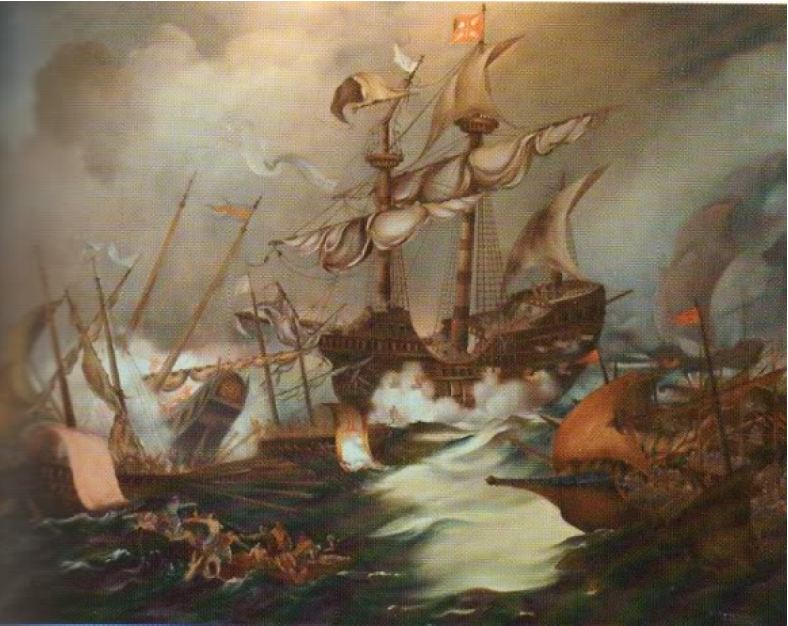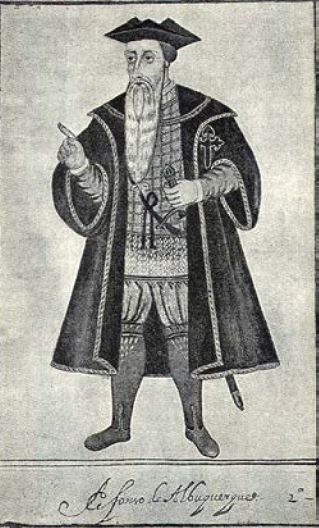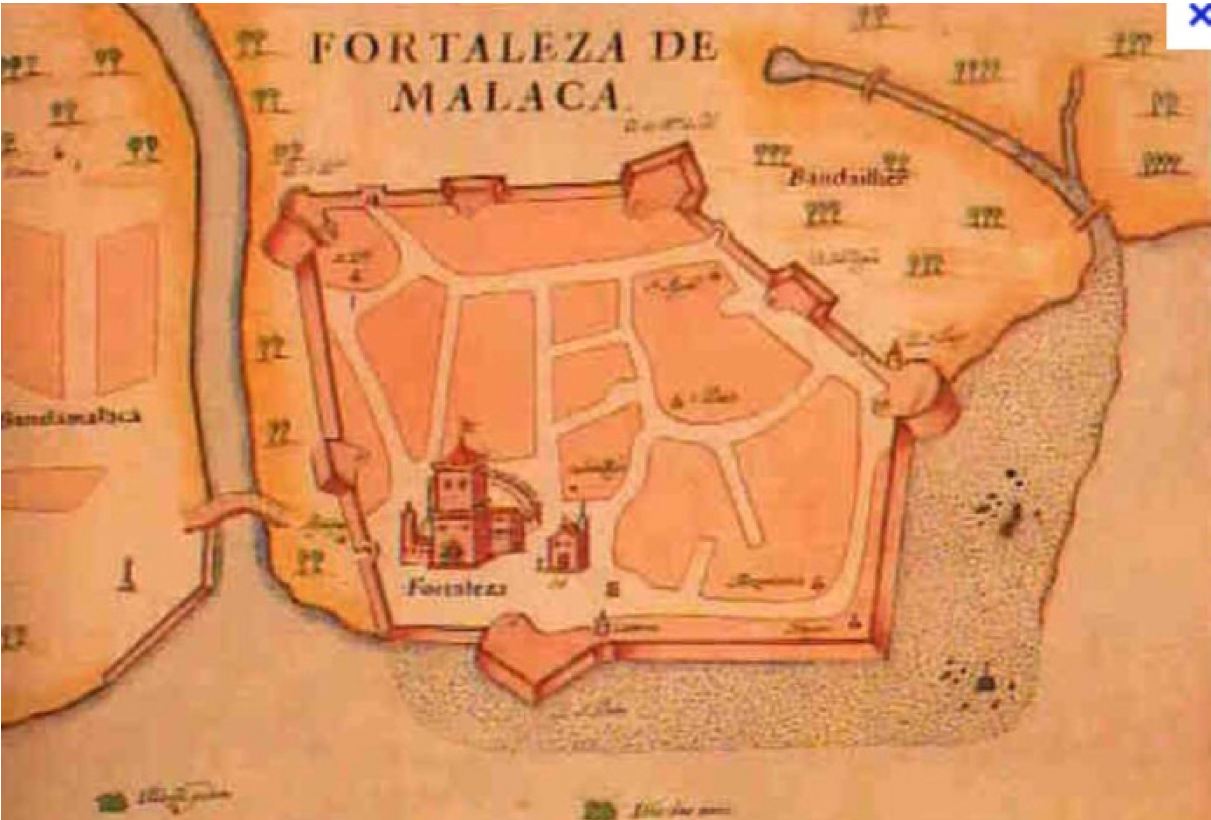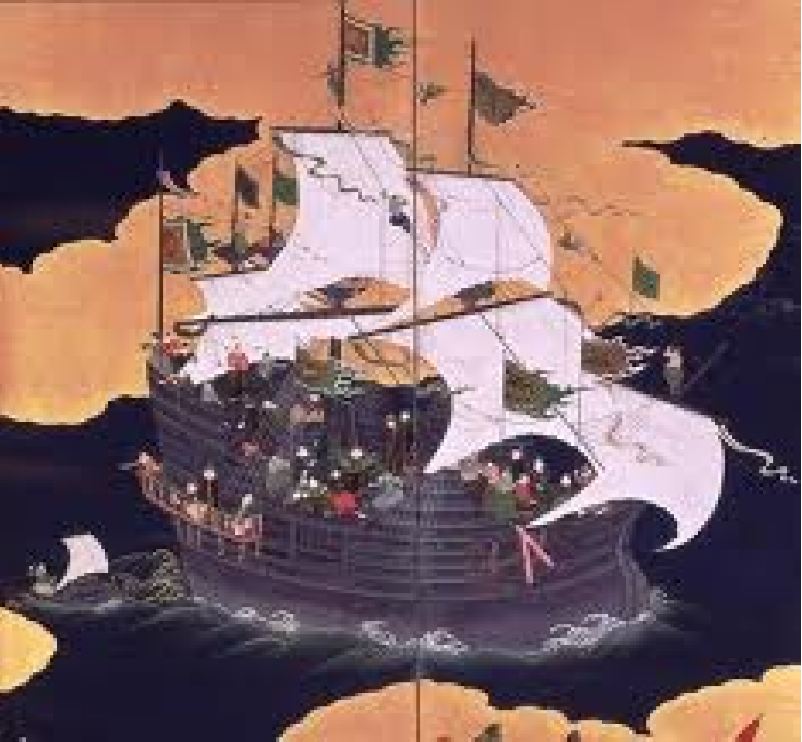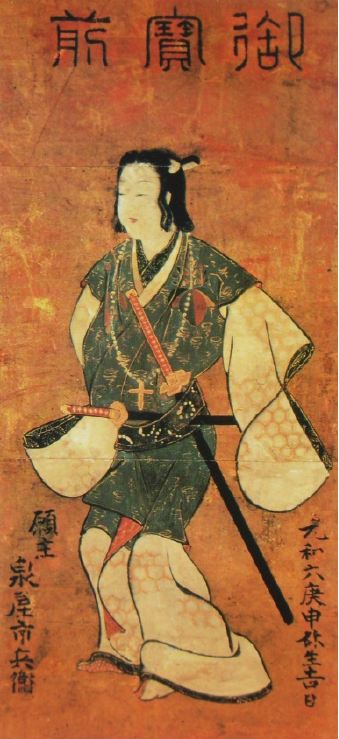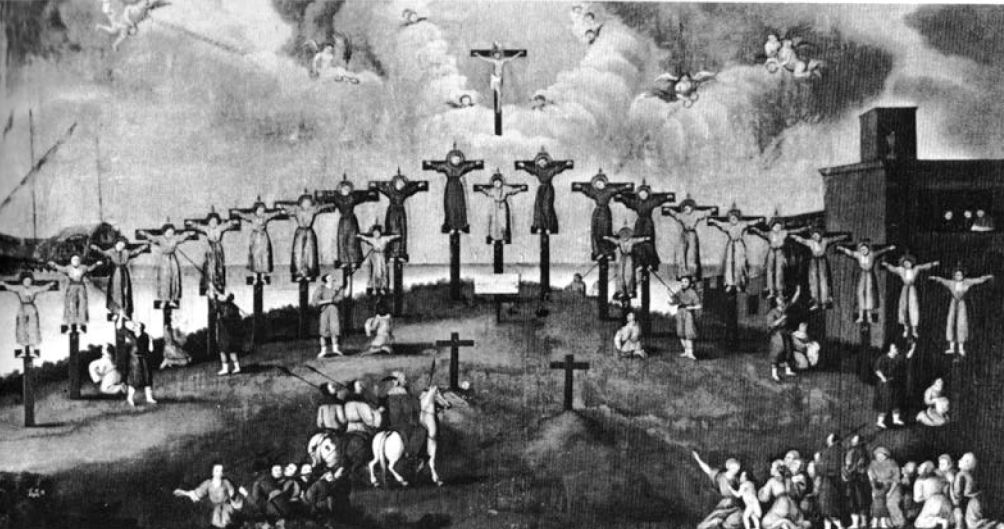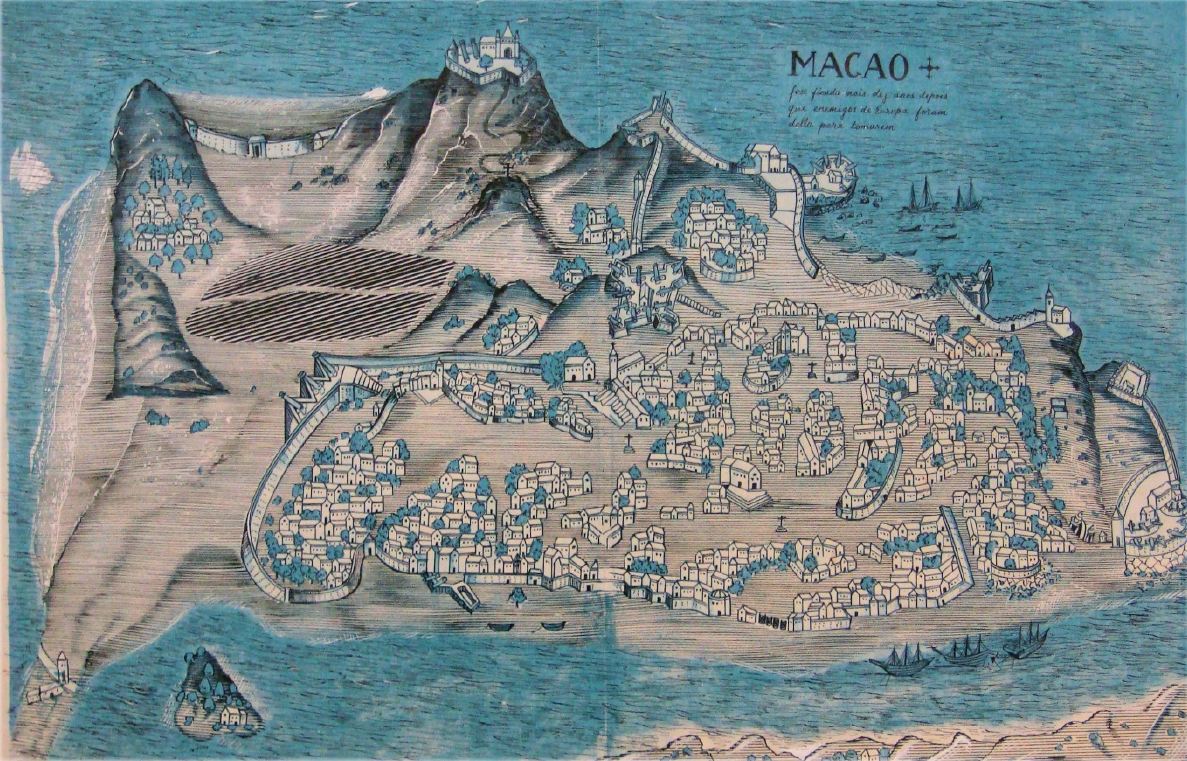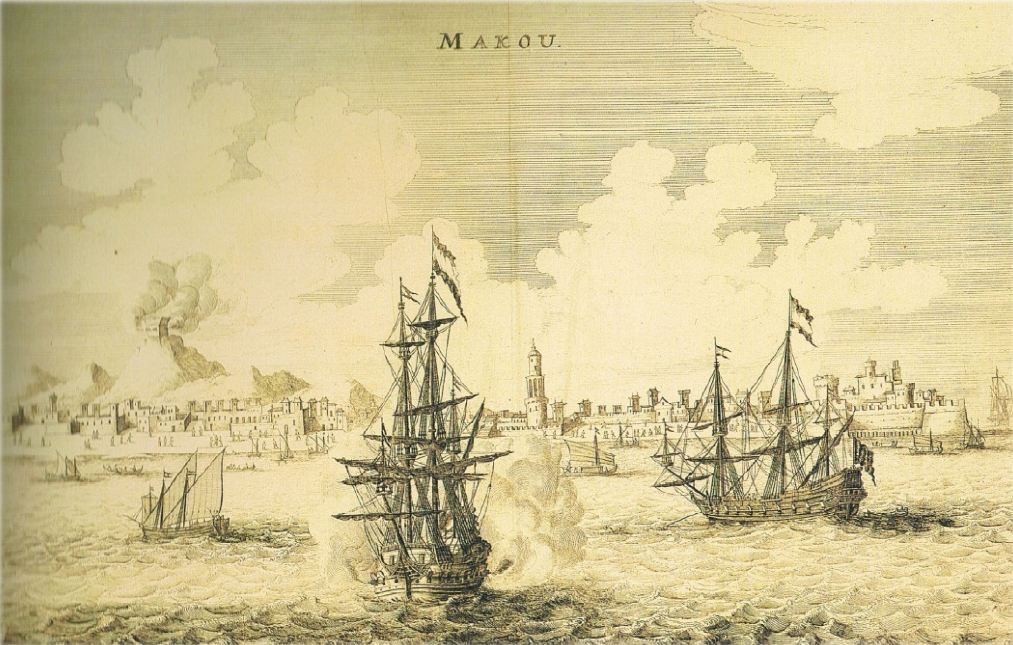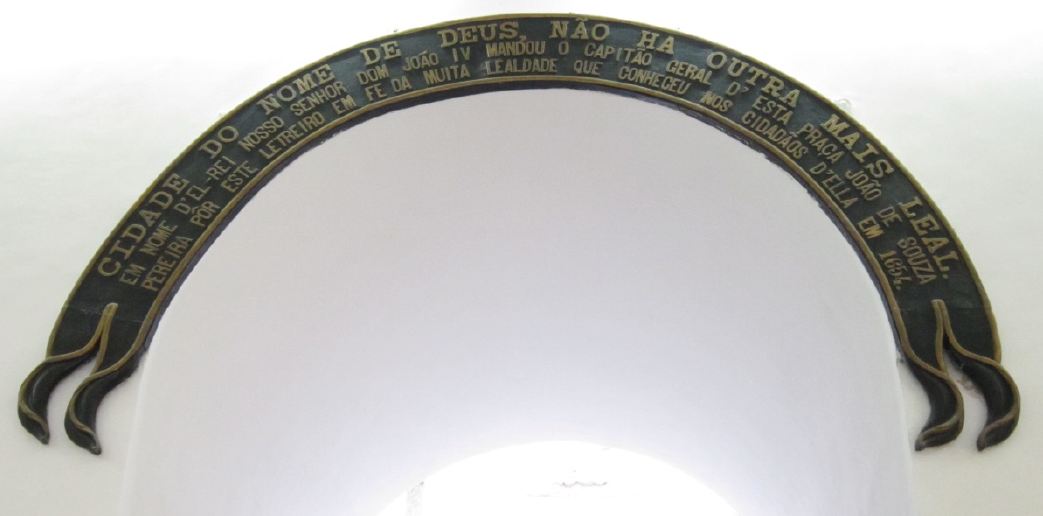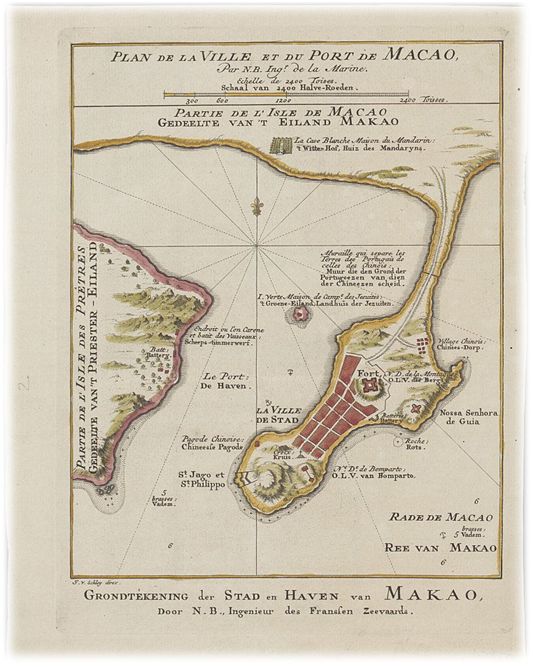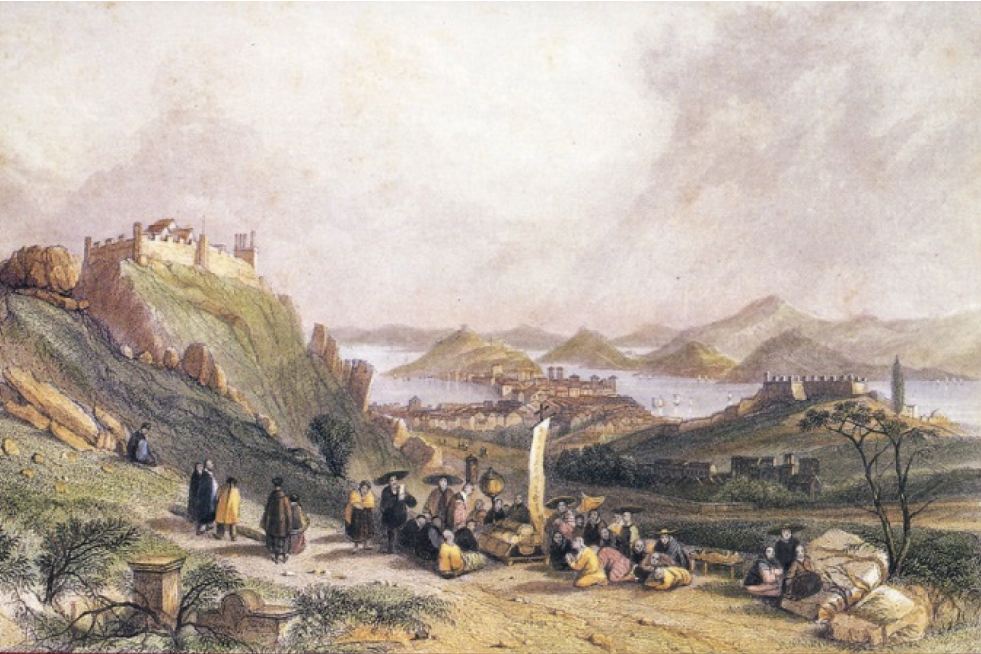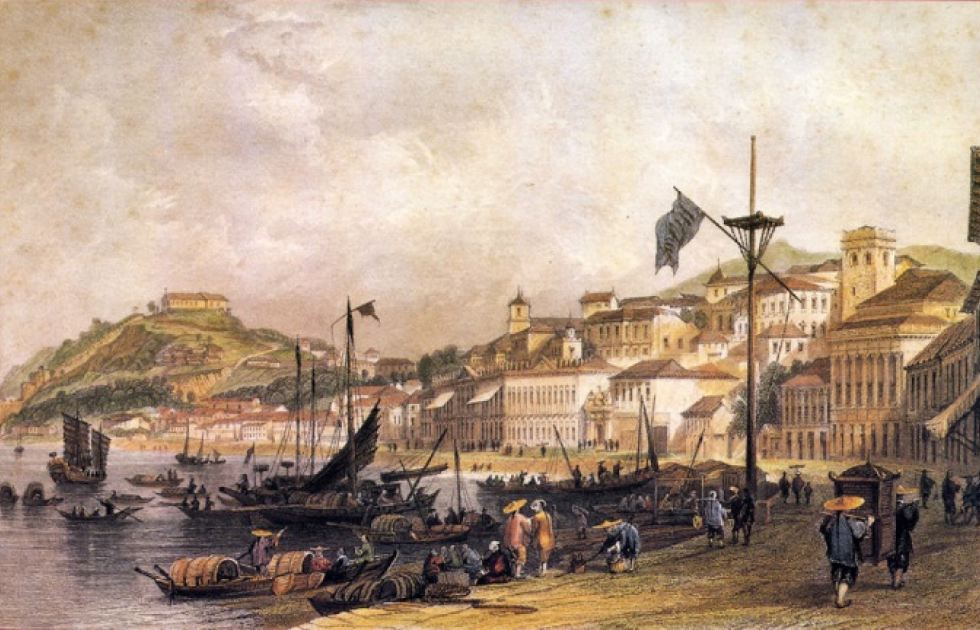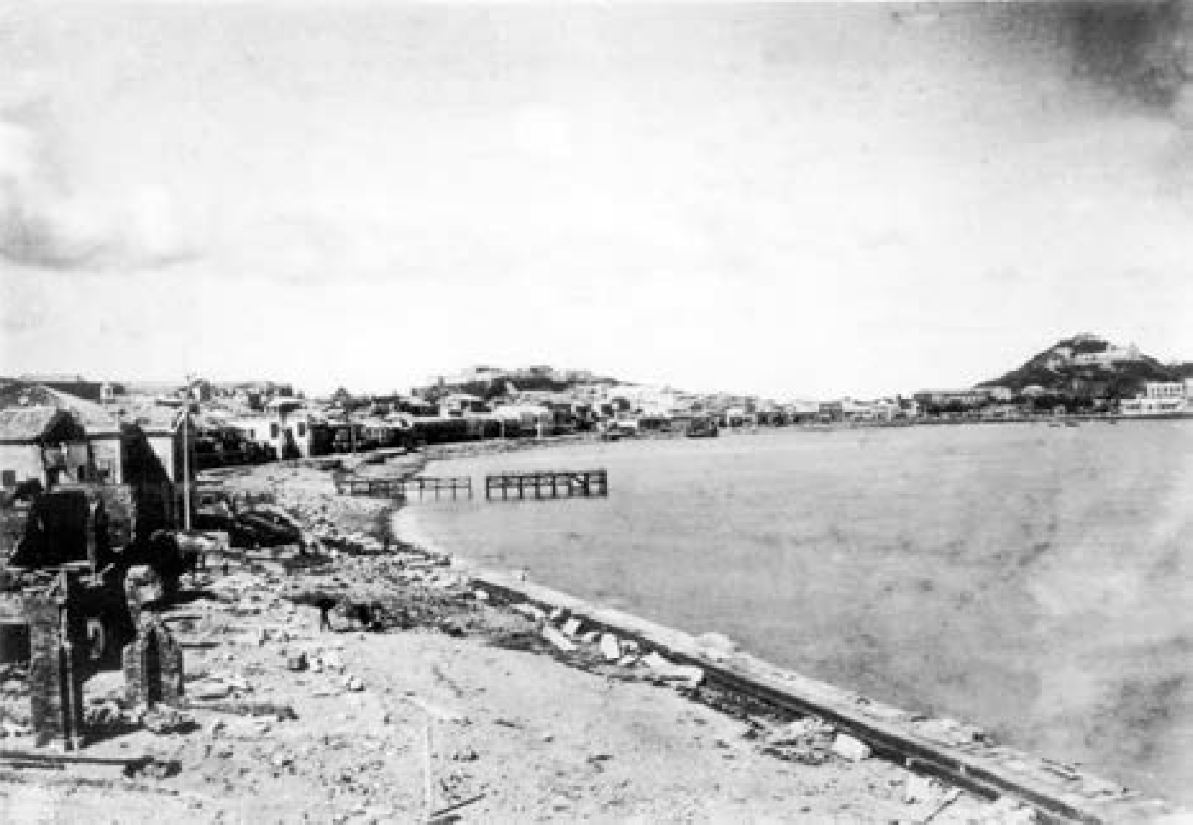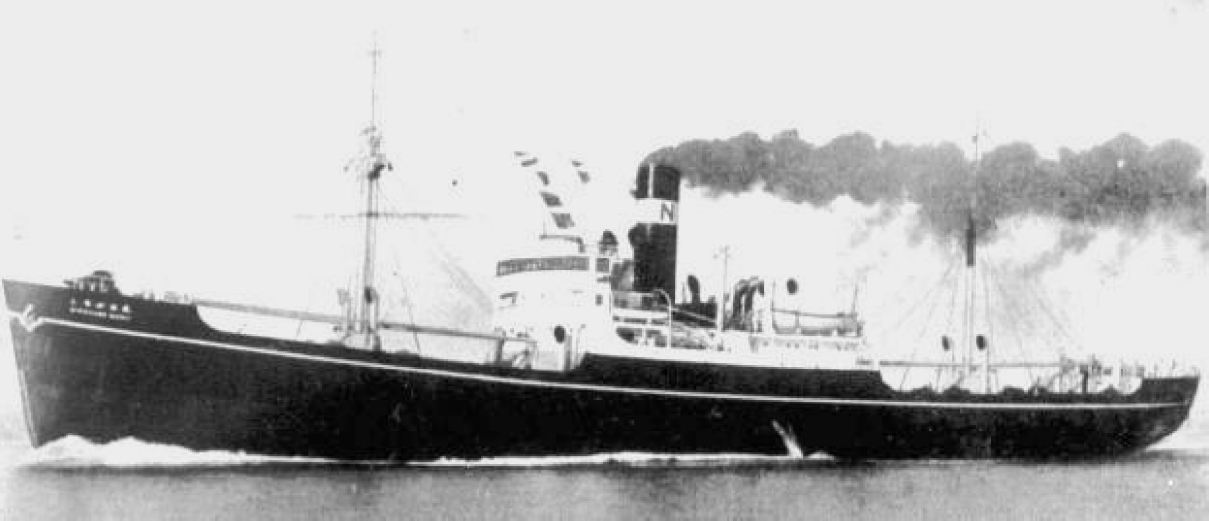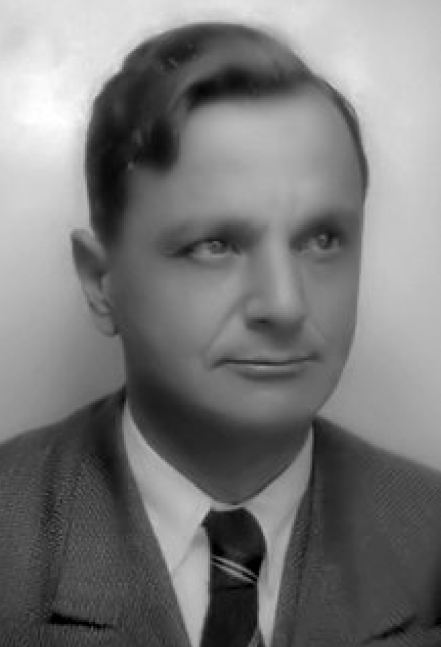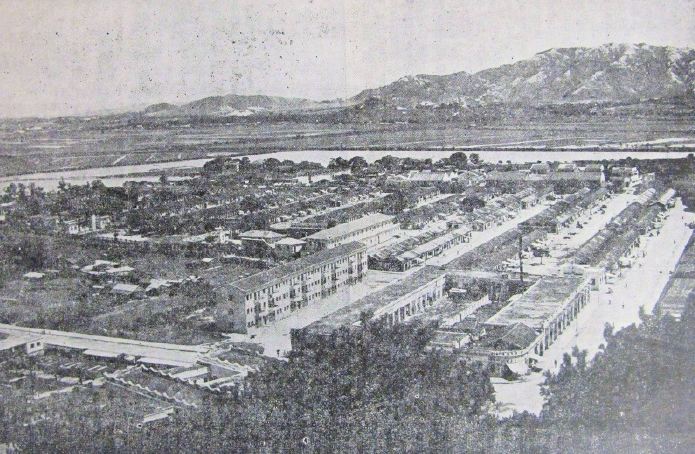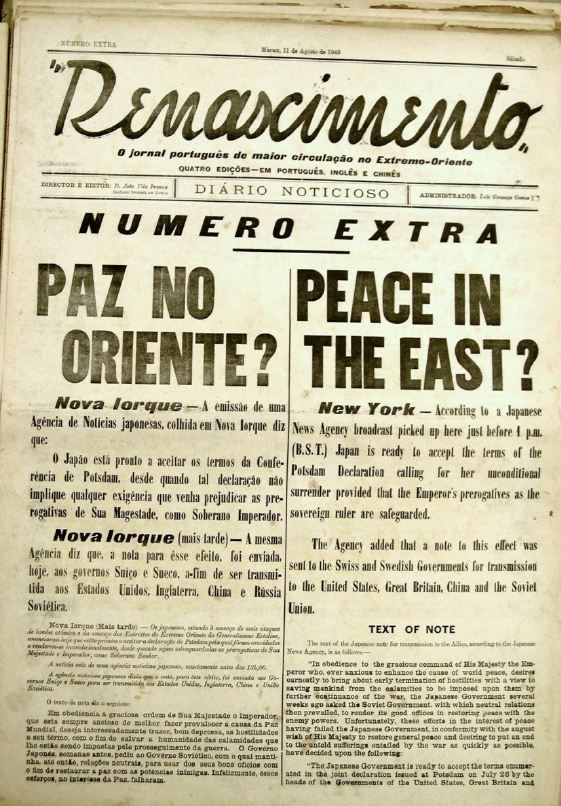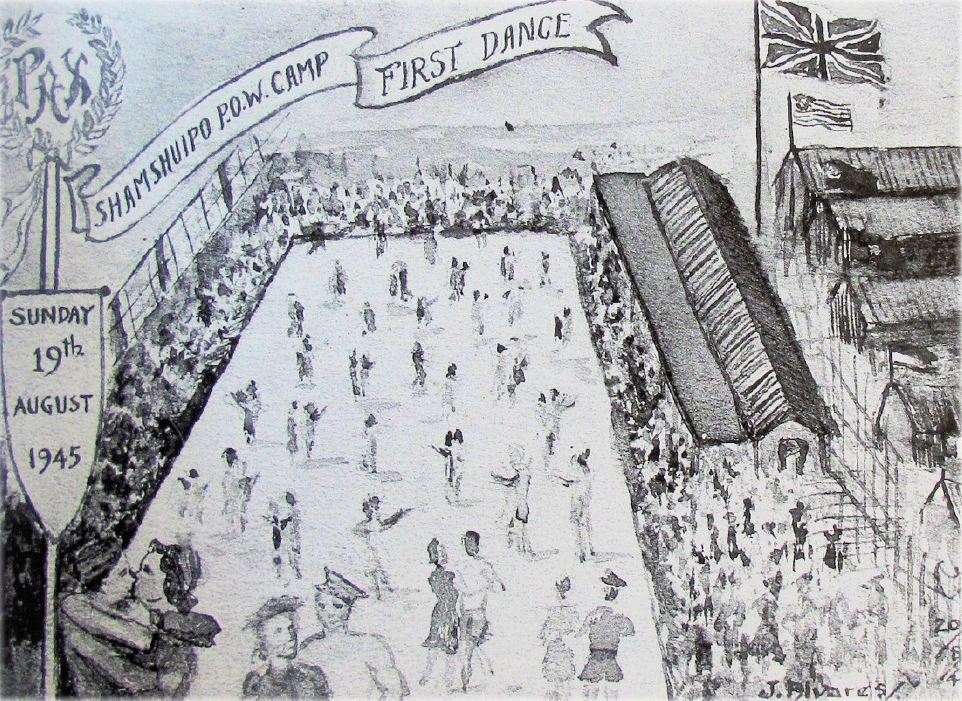MACAU:
TRIUMPH AND TRIBULATION
by Stuart Braga
Written at the request of Ed Rozario, President of the Casa de Macau Australia, this series of six essays outlines several aspects of the turbulent history of Macau over a period of four centuries.
They were first published in 'Casa Down Under' the newsletter of the Casa de Macau, Australia
© Stuart Braga 2013
ISBN: 978-0-9597261-5-2
Map of Macao in 1557
nla.gov.au/nla.map-brsc84
nla.gov.au/nla.map-brsc84
Click to see full image
This is a reconstitution by Eugenio Beca. In the absence of any cartographic record of the original Portuguese presence in Macau in 1557, Jack Braga commissioned this map to indicate the location of the first Portuguese occupation: the Fortim de S. Francisco commanding the entrance to a protected bay and anchorage. A much rebuilt wall of this small fort survives in the modern city of Macau. Beca has provided embellishments in the manner of 16th century cartography: an elaborate compass rose, a caravelle and the Portuguese royal coat of arms.
Two flags are firmly planted in Macau and Green Island to indicate that the Portuguese were here to stay.
Part 1 — Conquest and Conciliation — the Portuguese come to Asia
A dramatised painting of the Battle of Diu, 1509, which established Portuguese naval supremacy in the Indian Ocean for the next 100 years.
Click to see full image
Seeking a trade route to Asia, Portuguese seamen began to explore the west coast of Africa in the fifteenth century, at first cautiously, and then as they grew more familiar with ocean currents and remote coastlines, more boldly. By the end of the century, two great navigators had reached India, and commenced an era of Western influence in Asia that would change the world forever. Bartholomew Diaz rounded the Cape of Good Hope in 1488; a decade later, Vasco da Gama arrived at Calicut on the west coast of India. In the next twenty years, a string of some forty Portuguese forts dotted the coast of Africa and Asia as Portugal, a small country on the edge of Europe, established for half a century a commercial and strategic empire greater by far than any other power in Europe.
It was an amazing achievement, and it left its legacy for the next five centuries. The Portuguese occupation of Macau, which began in 1557, finally ended in 1999. Macau marked the furthest extent of the Portuguese empire. It was the first and last European colony in the Far East.
Colonial expansion is commonly the result of commercial prowess, often accompanied by religious zeal, sustained by overpowering military and naval force. This is broadly true of the astounding Portuguese conquests as they worked their way around the African coast and across the Indian Ocean between the late fifteenth and early sixteenth centuries. Francisco de Almeida who in 1506 was appointed the first Portuguese viceroy in the East, and his successor, Afonso de Albuquerque saw that to secure trade they must destroy any who might stand in their way. This they did in 1509 in the Battle of Diu, a major naval engagement off the Indian coast. At that time, the technological superiority of the Portuguese in shipbuilding and gunnery made it easy for Albuquerque to sweep his opponents from the seas. Arab dhows were no match for the far more manoeuvrable and better gunned Portuguese caravels and carracks.
Afonso de Albuquerque, the great Viceroy of Portuguese India, 1510-1515
Click to see full image
The next year, 1510, Albuquerque established a strong base at Goa on the west coast, held by a Muslim sultan. Albuquerque was a brilliant strategist, and with a much smaller force killed 6,000 of the 9,000 defenders. This, with two smaller domains, Diu and Damão, remained in Portuguese possession until 1961. The conquest was ruthless, bloody and swift. Portuguese religious and cultural superiority was at once asserted. Muslims were expelled and the practice of the Hindu religion was forbidden. Goa was seen as the springboard for the evangelisation of India in a remarkably militant way. It began with the establishment of numerous religious houses in Goa — convents, churches and seminaries. However, while Goa itself remained firmly Catholic, there was little impact beyond its boundaries. The impact of Portugal was in the long term demographic rather than religious. Some two thousand young men left Portugal each year to seek their fortune in India; few ever returned. Therefore Albuquerque encouraged inter-marriage with local women, thus beginning the long practice of racial integration that characterised Portuguese rule in sharp contrast to that of any other European empire.
A Prospect of the City of Goa
A Dutch view, 1719 from Herman Moll, A map of the East-Indies
National Library of Australia, RM 285
Click to see full image
The Portuguese fortress of Malacca, 1630
Click to see full image
The next year, 1511, Albuquerque attacked Malacca, a strong position on the coast of Malaya, defended by a force of 20,000. Conquering it with a force of 900 Portuguese, 200 Hindu mercenaries and about eighteen ships, he set about at once to build a vast and very strong fort, which was intended to be impregnable, and was seen as such for more than a century.
This fort, A Famosa (the Famous), was the starting point of Portuguese expeditions to China and Japan in the following half-century. Facing the sea, Albuquerque constructed a huge four-storey stone keep, Torre de Menajem, the Tower of Homage, built in a style which modern artillery had rendered obsolete in Europe by the sixteenth century; in Malacca, it was intended to impress rather than to protect. It impressed local sultans who sought in vain to oust these foreign interlopers. 130 years later, in 1641, it took the Dutch nearly three years to drive the Portuguese from Malacca after a long and bitter siege.
Further east lay China. The Chinese were known in India, where the voyages of the celebrated Chinese admiral Cheng some fifty years earlier left a strong memory. The Chinese were seen by the Indians as a civilised people with paler skins than themselves, and Albuquerque decided to venture further east. When he arrived at Malacca in 1511, he found a fleet of Chinese junks there. He soon sent one of his captains, Jorge Álvares to find whether trade could be opened with these mysterious and remote people. The Portuguese engagement with China was about to begin, but this time, it would be by careful conciliation. There are no great naval battles, bloody conquests or extended sieges in the long history of Macau.
Part 2 — The great days of Macau, 1557-1640
The first Portuguese attempts to trade with China in the early 16th century ended in disaster when an embassy was despatched to the Imperial Court at Peking, led by Tomé Pires whose book Suma Oriental was an important reference work describing the Portuguese eastern discoveries. He seemed to be the ideal man for what proved to be an impossible task. After lengthy delays, the Chinese found that the communication to the Emperor which came, not from the King of Portugal, but his underling, the Viceroy at Goa, was not in the form of abject submission deemed proper for barbarian rulers. Pires and his entourage were seen as dangerous spies and were thrown into prison in Canton, where some were executed in 1524, while the rest died miserably some years later, still in prison. The Portuguese had discovered, as did other Europeans over the next three centuries, that dealing with the Chinese authorities was difficult, unpredictable, and could be dangerous.
This disaster halted Portuguese trade with China for a generation. Cautiously, others ventured back. It took some time to persuade the mandarins in Canton that the 'Western barbarians' (Portuguese) were not a threat, and that to do business with them was highly profitable for both the merchants and the mandarins. Business in the Far East has always depended on suitable gifts being made, and it is probable that the first Portuguese traders to arrive in the 1540s near Canton made sure that their presents were sufficient to gratify the mandarins. They sheltered and traded at several places before they found a small rocky peninsula at the mouth of the Pearl River with a sheltered harbour. Already well-known to the Chinese, this place was the location of a temple built in the late 15th century for the worship of the goddess
A-ma. To the Portuguese the place became Ama-cao, eventually shortened to Macao or Macau. Within a few years a small settlement with a few mat sheds (temporary structures built of bamboo with rattan mats for walls) had grown up. In a few more years, this settlement had become far more permanent and costly, elaborate buildings had been erected.
How was this possible?
Macau and its merchants became, for about 70 years, the beneficiaries of a number of very favourable circumstances. The first of these was the decision made in the 14th
century by the Ming emperors in China to forbid trade with the Japanese, who they contemptuously called 'the dwarf barbarians'. The Japanese for their part made it punishable by death to leave Japan. This meant that these two Far Eastern empires developed in the next three centuries along divergent paths. In Japan, silver was relatively cheap; in China, whose currency system was based on silver, it became an increasingly precious metal as the population and economy grew under the stable administration of the Ming emperors.
A Japanese Painting of a Portuguese ''Black Ship'
Click to see full image
The second circumstance was the accidental discovery of Japan by the Portuguese. In 1542, Fernão Mendes Pinto and a companion who were trying to reach China were driven far north by a storm and reached Japan, where their arquebuses, early handguns, created a sensation. They were immediately copied by Japanese armourers. In the next thirty years, an amazingly profitable import/export business, referred to as the 'carriage trade', was set up, based on Macau. The Portuguese merchants found a ready market in Japan for Chinese silk, which commanded high prices, paid for in silver, by weight. Japan produced silk, but the Japanese much preferred Chinese silk, which was of better quality. Chinese silk was purchased in Canton for far less than it sold for in Japan. Seldom in human history can there been such a profitable trade, and for more than half a century until the early 17th century, the Portuguese held a monopoly of it.
A Japanese Christian
Click to see full image
In this period Macau became a boom town of fine houses, adorned with Chinese and Japanese furniture and art objects.1According to an amazed English visitor, Peter Mundy, in 1637. They were inhabited by richly dressed people waited on by numerous black African slaves. People came from Portugal to enjoy the bonanza. According to Fr Manuel Teixeira, a population of about 500 in 1561 grew to about 850 by 1635.2M. Teixeira, Os Macaneses, Macau, Centro de Informação e Turismo, 1965, pp. 34-39 No-one bothered to count the slaves, but an American estimate made much later, in 1835, estimated the number then at 800-900.3Elijah Bridgman in the Chinese Repository, November 1834, pp. 292, 303. Some 10,000 Chinese people had come to Macau by 1635, but few if any would have regarded it as their native place (heung ha), and no-one bothered to count them either.
Looking westwards, with the Praya Grande in the left foreground.
Click to see full image
Looking eastwards, with Green Island (Ilha Verde) in the left foreground.
Macau about 1640, a reconstruction by Vicente Pacia.
J.M. Braga Pictures Collection, National Library of Australia.
Click to see full image
Travellers to Macau in the early 17th century marvelled what they saw. FrAntónio Cardim, a Jesuit priest who lived there from 1632 to 1636, wrote:
Macao is put together of very fair buildings and is rich because of the commerce and traffic that are transacted there by night and day; it has noble and honourable citizens. In fact, it is held in great esteem throughout all the Orient, inasmuch that it is the depository of those goods using gold, silver, silks, pearls and other jewels; of all manner of drugs, spices and perfumes from China, Japan, Tonkin, Cochin China, Cambodia, Macassar, Solor; and above all, as it is the headquarters of Christendom in the East.'4Fr. A. Cardim, I Relazione della Provinzia del Giappone, quoted by the architectural historian Michael Hugo-Brunt, 'The Macao Collegiate Church of "Madre de Deus", "Mater Dei" of "St Paul's" ' in Journal of the Oriental Society of Australia, vol. 14, 1979-1980, p. 73.
There were wealthy families who became patrons of the arts, ardent supporters of the Faith and contributors to the life of the community. They supported a charitable brotherhood, the Santa Casa de Misericórdia (the Holy House of Mercy) and religious institutions such as convents and orphanages. A municipal council, known as the Senado, was established as early as 1585. Soon there were three parish churches, St Lazarus (the oldest), St Anthony and St Lawrence. In 1575 a new diocese was set up, based on Macau. Initially, the bishop was Bishop of China and Japan, for this was a missionary diocese. A fine cathedral was built, generally known as Sé. The main religious orders, the Jesuits, Franciscans, Dominicans and Augustinians soon arrived and set up missions. Each had its own church, dedicated to the appropriate saint, while the Jesuits, first in the field, built and then after a fire in 1602, rebuilt the great church which came to be known as St Paul's. Besides these were two churches attached to the Santa Casa de Misericórdia and the Santa Clara Convent, and a chapel attached to the Jesuit seminary of Nossa Senhora de Amparo, where Chinese Christians were trained for missionary service in China. Besides all these was a small chapel attached to the Senate House. The presence of all these churches and chapels, and the sound of their bells, dominated Macau.5C.A. Montalto de Jesus Historic Macao, p. 58, pointed out that the eleven churches in Macau provided for a European population of not more than 1,000.
If this great commercial and religious success seems too good to be true, it was. It all depended on two things: the continuing success of the hugely lucrative Portuguese monopoly of trade between China and Japan, and the willingness of the Chinese authorities in Canton to tolerate this wealthy place on their doorstep.
A warning of what was to come was the construction by the Chinese of a barrier wall between Macau and Chinese territory beyond in 1573, sixteen years after the first permanent Portuguese settlement. Portuguese were rarely allowed to go through its only door. Upon the door posts was a pointed inscription: 'Dread our greatness; respect our virtue'. Events would prove that these were no idle words.
There was no warning in Macau of the establishment in 1600 of the English trading business,the Honourable East India Company and its counterpart the Dutch East India Company (Vereenigde Oost-Indische Compagnie or VOC) in 1602. Both were to have a sustained and ruthless entrepreneurial drive that the Portuguese lacked. Even worse was a violent anti-Christian reaction in Japan which began in 1614 and by 1639 led to the horrifyingly cruel martyrdom of many thousands of Japanese Christians and a bloody end to Portuguese trade with Japan. At the same time, the Dutch were taking most of the trade westwards, and there was a violet upheaval in China as the Ming dynasty was overthrown by the Manchus. With all of its trade cut off, Macau faced certain ruin.
Part 3 — 'The Worm-like barbarians of Macau'
A century after the Portuguese navigator Fernão Mendes Pinto discovered Japan in 1542; Portuguese contact with Japan came to a sudden end. Henceforward, Japan was to be a closed kingdom for more than two hundred years. Only 160 years have passed since that long isolation ended. Hence the duration of Japan's important role in the modern world is not as long as its period of isolation. What went wrong?
The first half century of Luso-Japanese contact had been amazingly successful. An immensely profitable trade developed, to the great satisfaction of both parties. Jesuit missionaries went to Japan together with the merchants and gained what seemed a miraculous success in the western Japanese island of Kyushu, where Nagasaki is situated. By 1580, 150,000 people had become Christians, and the number grew to about half a million by 1615. Several of the daimyo, the feudal lords who wielded immense power in Japan, were converted.
Emboldened by this rapid success, Fr. Alessandro Valignano, perhaps the greatest of the Jesuit leaders in the generation after Francis Xavier, sent a printing press to Nagasaki. It was used for some twenty years to produce devotional and evangelistic publications. However, the mission was, strange to say, too successful. The same was true of the trade, hugely lucrative for the merchants who came once a year on the Japan voyage to sell silk for silver, far more valuable in China than it was in Japan. The monopoly they enjoyed was too good to last, and by the end of the 16th century, Dutch merchants had arrived, prepared to go to any lengths to drive out the Portuguese.
Apart from a commerce that was far too one-sided, the impact of Christianity was viewed with alarm by Japan's ruler, the Shogun, from his castle in Yedo, the city that is today Tokyo. For several centuries the Emperor in Kyoto had been a figurehead, while the Shogun, the head of Japan's leading noble family effectively ruling Japan. In 1600 there was a bloody coup, with 40,000 men killed in the battle for power. Following this, the Tokugawa clan assumed power in Yedo. Naturally, the new Shogun regarded any other form of allegiance as a threat to his own authority and set out to destroy it. In this way of thinking, the rise of Christianity was seditious. It must be mercilessly crushed, lest there be a reversion to the two centuries of instability preceding the rise to power of the Tokugawa clan. The last ruler of Japan before the coup, Hideyoshi, then the first three Tokugawa shoguns, Ieyasu, Hidetada and Iemitsu cracked down with increasing severity. Hideyoshi forbade the preaching of Christianity, and in 1597 six foreign missionaries and twenty Japanese Christians were punished for defying the edict. Their ears and noses were cut off, and then they were crucified. These 'Nagasaki Martyrs', as they became known, were the first of a great number killed in the next four decades.
The Martyrs of Nagasaki, by an unknown artist, was cleaned, restored and repaired in London with the help of commercial donations. The picture, possibly by a Franciscan friar, dates from the 1600s and was formerly in the São Francisco Church (long since demolished) but is now kept in the Seminary of St Joseph.
Click to see full image
Between 1614 and 1638 as progressively more severe policies were put into effect, Japanese Christians were wiped out in great numbers in a most cruel persecution concluding with a horrifying massacre in 1638 at Shimabara. This fortress held out for some time against the Shogun's forces, and was eventually reduced with help from Dutch artillery. 37,000 rebels were then killed, many by being thrown over a cliff into the sulphurous boiling springs at Unzen. Many more Japanese Christians renounced their faith and reverted to their former religious practices. A tiny remnant clung to their faith in secret in villages near Nagasaki. The descendants of these 'hidden Christians' eventually emerged in 1865.
Until the Shimabara rebellion, the Portuguese were tolerated for the trade they brought, though when a ship arrived its rudder and armament were removed to ensure that its crew were helpless. It was an impossible situation, and the last two Portuguese galliots left Nagasaki in 1639, having been forbidden to trade. In vain the merchants begged, tears running down their cheeks, that they were innocent, and that 'Macau gets nourishment from Japan, and if we are deprived of this trade we will all relapse into the utmost destitution. Immediately afterwards, the Shogun, Iemitsu, adopted a rigorous policy of excluding all foreigners except the Dutch, who were allowed to send one ship a year to Nagasaki where they were under close and humiliating supervision. Whereas the Japanese government had been curious and welcoming in the 1540s, a century later, in the hands of a new ruling family, it had become fearful and xenophobic. On 22 June 1636, even before the Shimabara revolt, Iemitsu issued what came to be known as the Closed Country Edict. It did not mince matters. It is quite lengthy, but the first three clauses set the tone for the other fifteen.
1. No Japanese ships may leave for foreign countries,
2. No Japanese may go abroad secretly. If anybody tries to do this, he will be killed, and the ship and owner will be placed under arrest.
3. Any Japanese now living abroad who tries to return to Japan will be put to death.
This third clause was directed at Japanese Christian refugees who had gone to Macau and would soon build the wonderful façade of St Paul's Church. Later clauses laid down what was to be done if any Kirishitan (Christian) was discovered, or, worse, a Baderen (Padre). Limited trade with the Portuguese was still tolerated at this stage, but within two years this ended. The Portuguese were seen as proselytisers, and the exclusion edict was rigorously applied.
In Macau, the Leal Senado decided on a last attempt at reconciliation. In June 1640, four leading citizens were sent to parley with the Japanese, accompanied by fifty-seven others. They took no merchandise whatsoever. Knowing their peril, they had all been to confession and received the sacraments of Penance and Communion before they left. The size of the embassy clearly indicated the importance of the issue as far as the Leal Senado was concerned. The viability of Macau was at stake. Once at Nagasaki, the envoys were treated in the same way as any Japanese Christian. In 1635 Iemitsu had hit upon an infallible way of rooting out Christians. A cross was taken to every household throughout Kyushu, and people were made to spit upon it and trample it under foot. It was a clear choice: apostasy or martyrdom. It was this that had precipitated the Shimabara revolt. Members of the Portuguese embassy in 1640 were given the same choice; none yielded, and on 3 August 1640, all 61 were beheaded and their heads displayed in the town market place. They were told that they were being treated with mercy. They deserved nothing but the most painful death, but because they had brought no merchandise, the sentence was being commuted to an easy death.
The Portuguese vessel was burnt, and the twelve underlings spared from execution were returned with an official rescript to Macau in a small Chinese junk. The aim of Japanese policy, explained its author, Kagazume Tadazumi, was 'to civilise people and make the people of far distant countries adore him is the virtue of the Supreme Commander'. He explained that all in Japan was harmony until 'the worm-like barbarians of Macau who had long believed in the doctrine of the Lord of Heaven wished to propagate their evil religion in our country'. After recounting at considerable length how the Japanese Christians had been exterminated, the rescript concluded, 'The Elders of Macau, when they hear the foregoing facts must acknowledge the righteousness of our country and be impressed by the strength of our military virtue.'6C.R. Boxer, The Great Ship from Amacon, pp. 331-333.
The news was devastating for Macau, but the immediate reaction was to honour 'the noble army of martyrs, in the words of that ancient hymn, sung by Christians since the 4th century A.D., the Te Deum Laudamus. There was a solemn thanksgiving in the cathedral, church bells were rung, and there was rejoicing. Relatives of the martyrs dressed, not in mourning, but in gala clothes. The embassy to Japan had failed, but they believed that now they had ambassadors in Heaven, interceding for them at the Throne of Grace. Without doubt, the pious people of Macau would also have reminded themselves of Tertullian's famous observation that 'the blood of the martyrs' is the seed of the Church'. However, spiritual rejoicing was one thing, but temporal realities had also to be faced. The traders expelled in 1639 were right: 'we will all relapse into the utmost destitution'.
Carlos Montalto de Jesus, the first Macanese historian to write in English, has observed, 'the prosperity of Macau received a deathblow; the Macaenses, plunged in misery and despair, found their sacrifices useless, their dignity outraged, their trade gone'.7C.A. Montalto de Jesus, Historic Macao, p. 105. There followed a very bleak, poverty-stricken future in which many people starved to death in the following four decades.
Part 4 — Hard times
Macau in the mid-17th century.
From the Braga collection, National Library of Australia. nla.map-brsc108.
Click to see full image
For most of its first century, from the 1550s until 1640, Macau was prosperous, but most of the next two centuries were a bleak, poverty-stricken time. The Chinese magistrate on Heungshan island, of which Macau is a small part, exercised strict and rigid control, and the King of Portugal had insufficient strength to do anything to help his remotest colony.
9
'Makou'. Engraving by Johan Nieuhof, ca. 1665
Click to see full image
Over time, the screws kept tightening. The Heungshan magistrate erected an administrative compound in an elevated position not far away in order to supervise Macau. There was no ignoring it; it was conspicuously painted white, and was therefore termed by the Portuguese the Casa Branca, the 'White House'. Its control and taxation were inescapable. One of many taxes was the payment of anchorage dues for Portuguese ships in the Inner Harbour. To ensure that these were paid, a Chinese Customs House was built within the city of Macau itself. A despatch to the Emperor from the Viceroy at Canton asserted that the Portuguese in Macau were 'a kingdom with great and many forts and a great and insolent population ... it would be proper to debar them from the commerce at Canton'.8A. Ljungstedt, An historical sketch of the Portuguese settlements in China, p. 67; C.A. Montalto de Jesus, Historic Macao, p. 115. This was done for a time, and Macau suffered even more.
There remained Goa, the important Portuguese base in India. Even this link was severed when the Dutch seized Malacca in 1641, and with better ships, dominated the narrow Straits of Malacca, thus cutting Macau off from its parent. The profitable Manila trade was also severed the same year, following Portugal's successful rebellion against Spain in 1640. In little more than a decade, Macau lost all its trading partners: Japan, China, Manila and Goa. It faced utter disaster. To make matters even worse, a plague broke out, and at Macau 7,000 people are said to have died, mostly Chinese.9F. C. Danvers, The Portuguese in India, vol. II, p. 292. Danvers added 'this effectually put an end to commerce there for a time'. Despite all this, the Portuguese clung tenaciously to Macau, with a resilience and a capacity for survival never displayed by later European powers in the Far East.
The church fared badly, too. Portuguese Jesuits in Macau found themselves in conflict, not co-operation, with the Spanish Franciscans and Dominicans from Manila in missionary activity throughout the Far East. It blighted the efforts of both, and with the collapse of trade and wealth, both missions went into a steep decline. The monastery of the Dominican Order had once numbered twenty-four. By 1670, there were only three, maintained in poverty with great difficulty.
Cidade do Nome de Deus. Não ha outra mais leal
'City of the Name of God. There is no other more loyal.' The bronze scroll above the arch at the entrance to the Council Chambers, the Leal Senado until 1999.
Click to see full image
There was only one straw to grasp at: the supremacy of the Portuguese Crown. Overshadowed by the Spanish in nearby Manila, the Portuguese in Macau clung doggedly to their separate identity after Portugal came under Spanish dominion from 1580 until 1640. During this time, Spanish kings left the remote, obstinate Portuguese outpost largely to its own devices. On the restoration of the Portuguese throne in 1640, the Macau Senate managed to send the new king, João IV, a gift of two hundred bronze guns, cast locally. King João, told of the tenacity of this tiny place at the remotest end of the earth, is said to have remarked wonderingly, não ha outra mais leal — 'there is no other more loyal'. Shortly before his death in 1654, it was added to the city's motto, and the Macau Council proudly bore the title Leal Senado, Loyal Senate, until 1999. It was a gesture that in reality meant little, because Macau was poverty-stricken, with a declining population, and left with little but a magnificent past upon which to dwell.
The deterioration was widespread. Braz de Castro, appointed governor and captain-general in 1648, declined the appointment on the grounds that the previous governor had been murdered.10C.R. Boxer, Fidalgos in the Far East, p. 274. A visiting Spanish Dominican friar, Domingo Navarrete, wrote in 1672 that 'it would take up much time and paper to write but a small Epitome of the Broils, Uproars, Quarrels and Extravagancies there have been at Macao'.11J.S. Cummins, The travels and controversies of Friar Domingo Navarrete, vol. II, p. 270. This was the sociology of ingrained poverty at work. A pattern developed of lack of insight, parochialism, incessant bickering and failure to grasp opportunities which became too deep to break.'
The worst year was 1662, when an uprising in Guangdong (Kwangtung) province led to an Imperial order that the coastline be evacuated. The Chinese population of Macau fled in a body, and the border was closed for three months. Many people starved to death, but Macau survived by the skin of its teeth because it suited the mandarins to allow it to remain as long as they were suitably bribed.
Navarrete described with disgust a deputation from the Leal Senado, to the Casa Branca:
They go in a body with rods in their hands to the Mandarine who resides a League from hence and they petition him on their Knees. The Mandarine in his Answer writes thus: 'This barbarous and brutal People desires such and such a thing: let it be granted.' Or 'refus'd them.' Thus they return in great state to their City and their Fidalgos or Noblemen with the Badge of the Knighthood of the Order of Christ hanging at their Breasts have gone upon these errands ... if their King knew of these things it is almost incredible that he should allow of them.'
A Dutch version of a French map — Plan de la ville et du port de Macao
The map shows the built-up area, the city walls and fortifications in considerable detail.
Braga Map Collection, National Library of Australia. nla.gov.au/nla.map-rm302.
Click to see full image
This was indeed forbidden by King João V in 1712, but in Macau, far from the royal court, nothing changed. These impoverished and demoralised people were cut off from their distant homeland and royal authority. The mandarin ruled here. From grim necessity, the councillors developed a practice of cringing obsequiousness to the Chinese authorities at the Casa Branca and at the Chinese customs house within their very walls. They had to do so in order to survive. Navarrete's Spanish view, hostile to the Portuguese, was that the people of Manila were free, but that the people of Macau were slaves to the Chinese. They were indeed trapped in a most unenviable situation, wracked by penury, and with no way out. Even if ships could be found to take them away, where would they go, and how would they evade Dutch control of the Straits of Malacca?
Nevertheless, through all of this period of some two centuries, despite the severe restrictions which they endured for so long, the Portuguese community of Macau continued to show an amazing degree of stubborn endurance. They are qualities that have lasted right to the present day, for we are the heirs of their persistence.
Part 5 — Struggle for survival
Things did get better, but only very slowly. The improvement could have been much greater but for several poor decisions. In the late seventeenth century, Jesuit influence grew at the Emperor's court in Peking, chiefly through the outstanding Jesuit astronomer, Fr Verbiest, who won the confidence of the Kangxi Emperor to such an extent that in 1685, he decreed that Chinese ports were to be opened to foreign shipping. This should have been a golden opportunity for Macau to recover much of its former status, but the opportunity to take it up slipped through the fingers of the Macau Senate, which viewed the imperial edict with resentment and suspicion. They saw it as depriving them of the monopoly rights of trade with Canton that Macau had under the Ming dynasty before it fell in the 1640s.
The emperor under-estimated the importance that foreign trade would come to have, but it began in a small way. Some control was needed, so in 1719 the Kangxi emperor, towards the end of his reign, again proposed to centre all the foreign trade of China at Macau. Incredibly, the imperial offer was once more rejected, seen as a 'Trojan horse', giving the Chinese a much larger presence in and control of Macau than they already had. The Senate baulked at he cost of having to provide fifty to sixty officials to administer the proposal. Perhaps the rejection was not as blinkered as it might have seemed. The Senate had seen too many instances of local mandarins squeezing all the money they could from any profitable operations undertaken by the Portuguese. Yet gradually they changed their view, but it was too late. In 1732, thirteen years later, the Yongzheng emperor renewed the proposal. This time the Senate was enthusiastic.
However, the Bishop of Macau was not, as it would bring English traders, Protestant heretics, into the City of the Name of God. Although foreigners were not permitted to reside in Macau, several had slipped in as 'lodgers'. Most were bachelors, and the effect on Macau's night life was predictable; these men were not monks. Fearful for the morals of his flock, the bishop persuaded the Viceroy of India, Pedro Mascarenhas, to over-ride the Senates wishes. In vain the Senate protested.
For the third time, Macau's chance of economic recovery was pushed aside, this time by the overriding authority of the Viceroy in Goa. Meanwhile, British merchants were taking a growing interest in trade with China. They dealt chiefly in tea, oriental curios and porcelain, which became known in Britain as 'china'. Opium came later. Their ships were larger, and already it was clear that the shallow water around Macau was hazardous for navigation. Following the Viceroy's ban, the British went to the nearby island of Lintin in the Pearl River estuary to bargain with Chinese merchants instead of calling at Macau.
Auguste Borget, 'Macau from the Forts of Heang Shan', 1839.
Looking south, Guia Fort is high on the hill on the left, Monte Fort on the right, with the city between, behind a protective wall. In the foreground is a Chinese funeral ceremony.
Click to see full image
In the mid-eighteenth century, the steady growth of foreign trade led to a Chinese reconsideration of the basis on which it was conducted. Only in Canton was the administrative machinery sufficiently well developed to regulate trade and traders on both sides. In 1760, all ports were therefore again closed except Canton, and a set of eight regulations issued governing trade. As usual, the prohibitions these contained were negotiable by the time-honoured means of 'squeeze'. However, in one case there was no room for compromise. No foreign women were permitted in Canton, and foreigners were permitted to reside there only during the trading season, confined to a small area outside the walled city. The reason was obvious. The Chinese knew that permanent residency of foreigners of both sexes would create another European colony.
This created an immediate problem for nearby Macau, which had not long before banned foreign, i.e. Protestant, residence. If Macau continued to exclude foreign residents, they were likely to force their way in. If so, the Chinese were unlikely to stop them, because it was convenient to have them close at hand, but not within the camp. For the Senate, a pragmatic solution was vital lest Macau lose all its trade. So the ban was lifted, despite the objections of the bishop; foreigners might live in Macau, but they were not permitted to own property.
The Senate was right in supposing that this step was essential to the survival of Macau. Many years later, an English army officer observed, 'the English merchants only rent houses here, but since they have been forced to retire from Canton and to reside in this place, Macao has risen from an almost ruined to a very flourishing condition. The Portuguese as well as the Chinese thrive on British wealth and industry.' Poverty that had ground down the Macanese for generations began to ease, chiefly through the vigorous enterprise of the newcomers, especially the East India Company. This huge mercantile company was the worlds first multi-national corporation. Its business was effectively globalised three centuries before the term existed.
At the beginning of the eighteenth century, trade in opium was insignificant, but it was growing in value and the number of addicts in the Canton area was also growing. Recognising opium to be a dangerous drug, the Yongzheng Emperor prohibited its importation in 1729. As usual, this prohibition was seen in Canton as no more than yet another opportunity for extracting 'squeeze from foreign merchants, and the imperial ban was quietly ignored. At that time, no-one could have foreseen that the insatiable Chinese demand for opium and the vastly increased supply of it from India would eventually lead to war between Britain and China.
Thomas Allom, the Praya Grande 1843.>
The artist's original description reads, in part: 'It presents a striking and agreeable appearance. A row of handsome houses, extending along the beach for upwards of seven hundred yards, is built in a crescent form.'
Click to see full image
From the late eighteenth century, the illegal trade flourished and after 1833, when the East India Company withdrew from the China trade, it boomed in the hands of unscrupulous private traders such as Jardine and Matheson. The consequences were disastrous for China, but in the short term led to the triumph of British commercial and strategic power in the Far East. The Opium War broke out in 1839, and the Chinese were humiliated. Their ports were thrown open for trade and in 1841 Hong Kong was occupied by the British, who ruled it until 1997.
Indirectly, the consequences were also disastrous for Macau and its people. Within a few years the British and other foreign merchants left Macau, whose economy all but collapsed. An English journalist in Hong Kong wrote in 1844: 'We have before us a most melancholy account of the deplorable state of affairs in Macao. The Government are literally bankrupt. Not a stiver to pay a few miserable half starved troops ... We hear that since April the exchequer has been empty, — the troops threaten that they will stand it no longer and a riot is far from improbable. (William Tarrant, Hongkong, 1839 to 1844, p. 144.) It did not come to this, but the situation was indeed grim.
The Praya Grande, devastated by the Great Typhoon of 1874
Click to see full image
In the following decades, many Portuguese youths left Macau for better opportunities in Hong Kong, Shanghai, Japan and other locations throughout the Far East. Perhaps the lowest point was the Great Typhoon in September 1874, which devastated Macau, leaving at least 2,000 dead. In the next few months several hundred people fled to Hong Kong from Macau. Its historian, Carlos Montalto de Jesus, sadly commented that 'the disastrous typhoon consummated the ruin of the Macanese' (Historic Macao, p. 429).
A few nostalgic émigrés would sometimes return at weekends. A modern vignette by Amadeu Gomes de Araújo of their impressions gives some understanding of the sleepy backwater that Macau became in a chapter Caminhos Cruzados ('Crusaders Paths') of his book Diálogos em Bronze: memórias de Macau:
In the lobby of the Hing Kee Hotel, the aroma of jasmine tea added pleasantly to the murmur of that Sunday morning. The space was ample and comfortable, devoid of luxury. Around the small rosewood tables where teapots were steaming, portly weekend clients reclined on worn Victorian sofas and armchairs, speaking in English. The majority, who had arrived the night before, came from Hong Kong and Canton to drink and play fantan, a Chinese betting game. In their conversation, which was always animated, they invariably contrasted the decline of old Macau, with no port or infrastructure, with the charm and wealth of the young and vibrant Hong Kong.'
It would take another half century before things changed. Then they changed radically. The Japanese Occupation during World War II reversed the flight of refugees as perhaps 200,000 people, mostly Chinese, but including more than 90% of the Portuguese population of Hong Kong, fled to Macau. This was a period which the English writer, Austin Coates, described as 'Macau's finest hour'.
Part 6 — Macau's finest hour
Hong Kong fell to the Japanese on Christmas Day 1941. There was a Japanese victory parade, but few came to watch it. Two who did were Francis Ozorio and his brother Charles, boys of eleven and eight, who cowered at the roadside as the Japanese troops marched past. 'We were bloody terrified,' said Francis. Their heads bowed low, they were amazed to see that these soldiers who had defeated the British Army were shod with cheap shoes with canvas uppers. Their lack of good equipment had not stood in the way of a victory that brought Hong Kong to its knees.
Francisco ('Frank') Soares, the Acting Portuguese Consul, had already grasped the situation firmly, and realised that the broadest possible definition would have to be given to nossa gente, our people. In practical terms, this meant the granting of Portuguese citizenship to hundreds of people who had hitherto claimed to be British. This would enable them to obtain Third National [i.e. neutral countries] passes from the Japanese authorities. This later created criticism, it being said that he granted papers to people whose only claim to have anything Portuguese in them lay in that they had eaten Portuguese sardines. They now clamoured for Portuguese Identity Cards, wore arm-bands bearing the Portuguese colours and sought refuge in Macau. 12Leo d'Almada e Castro, 'Some notes on the Portuguese in Hong Kong', Address at Club Lusitano, Hong Kong (Instituto Portuguˆs de Hong Kong, Boletim no. 2, September 1949, p. 274).
Soares issued some 600 certificates of Portuguese nationality.13J. Forjaz, Famílias Macaenses, vol. 3, p. 829. Without doubt this action saved lives; he was Hong Kong's Schindler. His grandson, Bosco Correa, explained what occurred. 'When the Japanese attacked Hong Kong on 8 December 1941 my grandfather, then 74 years of age, was the Acting Consul for Portugal. He decided to move the Consulate from the Bank of East Asia Building in Des Voeux Road, Central, to his home in Homantin. When Kowloon was abandoned a few days later by the British forces who fell back to Hong Kong Island, looters took over Kowloon and he opened his home and gave refuge to some 400 refugees, mainly Portuguese residents from Homantin and Kowloon Tong.'14Bosco Correa's reminiscences, quoted by A.M. Jorge da Silva, The Portuguese community in Hong Kong, a pictorial history, vol. 1, p. 32.
The Portuguese community was in some ways even worse off than the British, who were at least given scanty rations by their captors in internment camps. Portuguese civilians were not. Those paid weekly would have received their last pay on Saturday 6 December; those paid monthly, at the end of November. Poorly paid clerks living a hand-to- mouth existence were in dire straits, and there was real distress, though not on the scale of the afflicted Chinese working class. Poor Chinese died of starvation by the hundreds every day'. William Vallesuk, Chief Radio Engineer of China Electric Co. Ltd, described the harrowing situation.
'Never, as long as I live, will I forget the scenes of horror, of inhuman suffering, that I have witnessed. People dying by hundreds in the streets; mothers — themselves on the doorsteps of death — wailing over corpses of their infants; a child of six beheaded in the middle of the street — bullets are too precious to waste — for snatching a handful of rice from a military canteen; women and old men slowly tortured — until they begged for death — for forgetting to bow to a sentry. To a man accustomed to a normal, routine mode of living, these things will sound incredible, unbelievable — yet they happened, and what's more, I've seen them happen with my own eyes'.15A letter written in the Embassy of the USSR, Chungking, 9 September 1943, held by Stuart Braga.
The Shirogane Maru
Click to see full image
The Macau government quickly came to appreciate the grave situation of nossa gente in Hong Kong. A trickle of refugees began in the motor trawler Perda as early as 10 December, the third day of fighting. After the surrender it became a flood. Arrangements were made for a ship-load of refugees to go to Macau on 8 February 1942 in the Shirogane Maru. These were people without work or resources. They arrived in Macau destitute and starving.
Pinky da Silva was on the ship. He wrote his recollections some years ago. 'About 250 plus Hong Kong Macanese assembled at the Blue Funnel Line Holt Wharf at Tsimshatsui, Kowloon. About mid-morning we boarded the ferry which used to ply in Japan's Inland Sea and was commandeered to serve in the Imperial Japanese Navy. All the officers and crew members wore Japanese naval dark winter uniforms. Canvas awnings shrouded the whole deck but I was able to peer through a viewing space on the starboard side throughout the 4 or 5 hour voyage to Macau.
It was a miserable February day of light drizzle. We arrived in the afternoon at Ponte 16, at the end of Avenida Almeida Ribeiro and close to the Kwock Chai Hotel, then one of Macau's tallest buildings. After an hour or two of paper work and arrangement we (I guess the whole assemblage) proceeded to Colegio de Dom Bosco (opposite Igreja de Sao Lourenço) for a hot meal of well-received fish conjee. Meanwhile, Macau families were waiting outside to greet and embrace their Hong Kong Macanese comterraneos.
At this juncture certain groups were allotted to stay at selected places such as Velho Amazem, Casa Luso-Chinesa (near Igreja de Sao Augustinho), Tung Hoi (an abandoned ferry boat), Fat Chee Kee (a housing project) and so on. I was already tired when my family proceeded to Gremio Militar (now Clube Militar). We bunked there with some others for about three days when Leo de Almada e Castro and Jack Braga arrived and selected certain families to go to Hotel Bela Vista which was to become the premier refugee center. Bela Vista Refugee Center as it was then called had a spacious kitchen as befitting a hotel geared for large dinners. The Bela Vista Refugee Center Kitchen cooked and provided meals to about two or three other refugee centers daily.' There was another shipload of 616 on 20 April and a steady flow for the next three years.
Gabriel Maurício Teixeira
Governor of Macau, 1940-1946
Click to see full image
Leo d'Almada, the outstanding leader of the Hong Kong Portuguese community, called Macau 'the miracle of the time'. 16L.A. de Sá, The Boys from Macau, p. 137. Later, borrowing Churchil's famous phrase, Austin Coates referred to the war years as 'Macau's finest hour'. 17A. Coates, A Macao Narrative, p. 103. Both comments were just. Governor Gabriel Teixeira did not need to go out of his way to provide a safe haven for so many refugees. In making them publicly welcome, and in making available every possible public building for their accommodation, he established the merciful policy that his administration then pursued until the end of the war. Teixeira could easily have taken the view that Macau had already done enough, and that public services were stretched to breaking point as it was. He could have concluded that the Japanese had created this problem by occupying Hong Kong, planning for it to become the regional centre of their grand design, the 'Greater East Asia Co-Prosperity Sphere'. Let them show what they could do, and harness the capabilities of the people they had inherited.
Perhaps the strongest reason not to accept Portuguese refugees from Hong Kong was that they or their forebears had turned their backs on Macau. If Macau meant so little to them then, why should Macau lift a finger for them now? If any of these considerations crossed Teixeira's mind, he quickly dismissed them. The disaster in Hong Kong had precipitated a massive humanitarian crisis. In the three and a half years of the Japanese Occupation, thousands of people fled to Macau, most of them taking with them little more than what they could carry. Austin Coates, a writer with a close knowledge of and interest in Macau, wrote of this period in generous terms.
'The whole of the gambling taxes — $2,000,000 — were made over by the government to the assistance of refugees. Indeed Macao's entire conduct during the period from Christmas 1941 to August 1945, when Hongkong was under Japanese occupation, was a gesture of unselfish friendship, made in Portugal's traditional style, regardless of dangers which others less magnanimous might have thought it more prudent to avoid. The patient endurance of the Macanese during these fateful years, and the sagacity and foresight of their Governor can hardly be overestimated ... no one who experienced Macao's hospitality during these years would ever forget it. The entire episode ranks as one of the city's finest moments'.18Ibid., pp. 103-104.
Bairro Tamagnini Barbosa: basic refugee cottages built in the 1930s for Chinese refugees from canton, but crowded during the war with Portuguese refugees from Hong Kong.
A rather rough photograph from J.M. Braga, 'Hong Kong and Macao.
Click to see full image
The bairro had row upon row of single-storey huts, each with one room and a tiny kitchen. Measuring no more than 20 by 20 feet in total area, each hut had a packed earth floor, a tile roof, a high Chinese style cement threshold you had to step over, and no plumbing. The hut's two windows had no glass panes: they were just barred with wood strips, and on the outside were plain wooden shutters.'
Jorge Remédios, UMA Bulletin, 1999
According to Jack Braga, almost ten thousand of Hong Kong's Portuguese population fled to Macau. Many were able to claim British nationality and sought assistance from the British consul, John Reeves. Initially appointed as vice-consul in what was for the British Foreign Office a remote and insignificant outpost, this young diplomat became a key man between 1942 and 1945. It was John Reeves' responsibility to assist in the care of the thousands of refugees as best he could. Reeves had been sent to Macau shortly before the outbreak of war for a 'rest cure' from Mukden, in Japanese-occupied Manchuria, a forbidding place at the best of times. Some rest cure! At the British consulate in Macau flew the Union Jack, the only Allied flag between India and Alaska, apart from the embassies in Chungking. It was a beacon of hope for desperate people. The British government agreed to pay its citizens a small subsidy. Theresa Yvanovich da Luz wrote that 'dependants of each Hong Kong Portuguese in prisoner of war camps received 30 patacas a month from the British Consulate and rations from the Macau Government like oil, rice and bread. That did not buy very much as food was scarce and expensive.'19In A.M. Jorge da Silva, The Portuguese community in Hong Kong, a pictorial history, vol. 2, p. 36. This matched the Macau government's subsidy to other Portuguese refugees, but was much lower than the $120 subsidy paid to British subjects.
The cost of food steadily increased as the war dragged on. By the end of 1943, it was, according to Paul Braga, 20 to 60 times its pre-war rate. He went on: 'the effect this malnutrition has on people in Occupied parts is indescribable. With the exception of those who work with or for the Nips, practically everyone has a colourless, parchment-like skin. Each has that drawn expression of constant strain and worry, and hardly without exception, they are very considerably underweight.'20Paul Braga to Hugh Braga, 1 November 1943. Paul Braga Papers, held by Stuart Braga. Every day for three years and eight months was a day of gnawing hunger. Even the fabulously wealthy Sir Robert Ho Tung, who had also fled to Macau, ran short of funds. However, while in Macau there might be privation, in Hong Kong there was fear, mass starvation, constant brutality and sudden, violent death.
A special issue of the Macau newspaper, Renascimento, printed on 11 August 1945.
The report was three days early. Japan did not surrender until 14 August, 8 days after the first atomic bomb was dropped.
Click to see full image
The surrender of the Japanese in August 1945 took everyone by surprise, though they knew it must be close. In Macau there were special services at churches and at the mosque. The papers ran special peace editions. In Hong Kong, as news broke at Shamshuipo POW Camp where the Portuguese boys who had served with the Hong Kong Volunteers were imprisoned, 'the joy of the men knew no bounds. There were scenes of near hysteria.' 21Luigi Ribeiro, 'Personal account of war experiences', p. 22. They put on a dance on 19 August, just five days after the surrender. José Álvares celebrated the event with a triumphant drawing. 22A.M. Jorge da Silva, The Portuguese community in Hong Kong, a pictorial history, p. 183. In Macau, Jack Braga, manager of Watco, the Water Company, who had worked hard to keep its vital supply flowing, waited until his friend and fellow historian Charles Boxer was freed from the Argyle Street POW Camp and came over. Together, they enjoyed what Boxer said was 'the last bottle of ginginha (cherry brandy) in the colony.' 23D. Alden, Charles R. Boxer: an uncommon life, p. 264.
The first dance at Shamshuipo Prisoner of War Camp, 19 August 1945.
Five days after the Japanese surrender, there was no shortage of girls to dance with.
Click to see full image
Macau soon returned to its peaceful pre-war condition. All of the British and most of the Portuguese refugees returned to Hong Kong as soon as it was in a fit state to have them back. Jack wrote in March 1946 that 'things get quieter and quieter in Macao, with so many less people living here'.24Jack Braga to Olive Braga, 29 March 1946. James Braga Papers, held by Stuart Braga. It would take another generation, and the dawn of prosperity in China to bring back to Macau the abundant wealth she had known in her earliest days.

